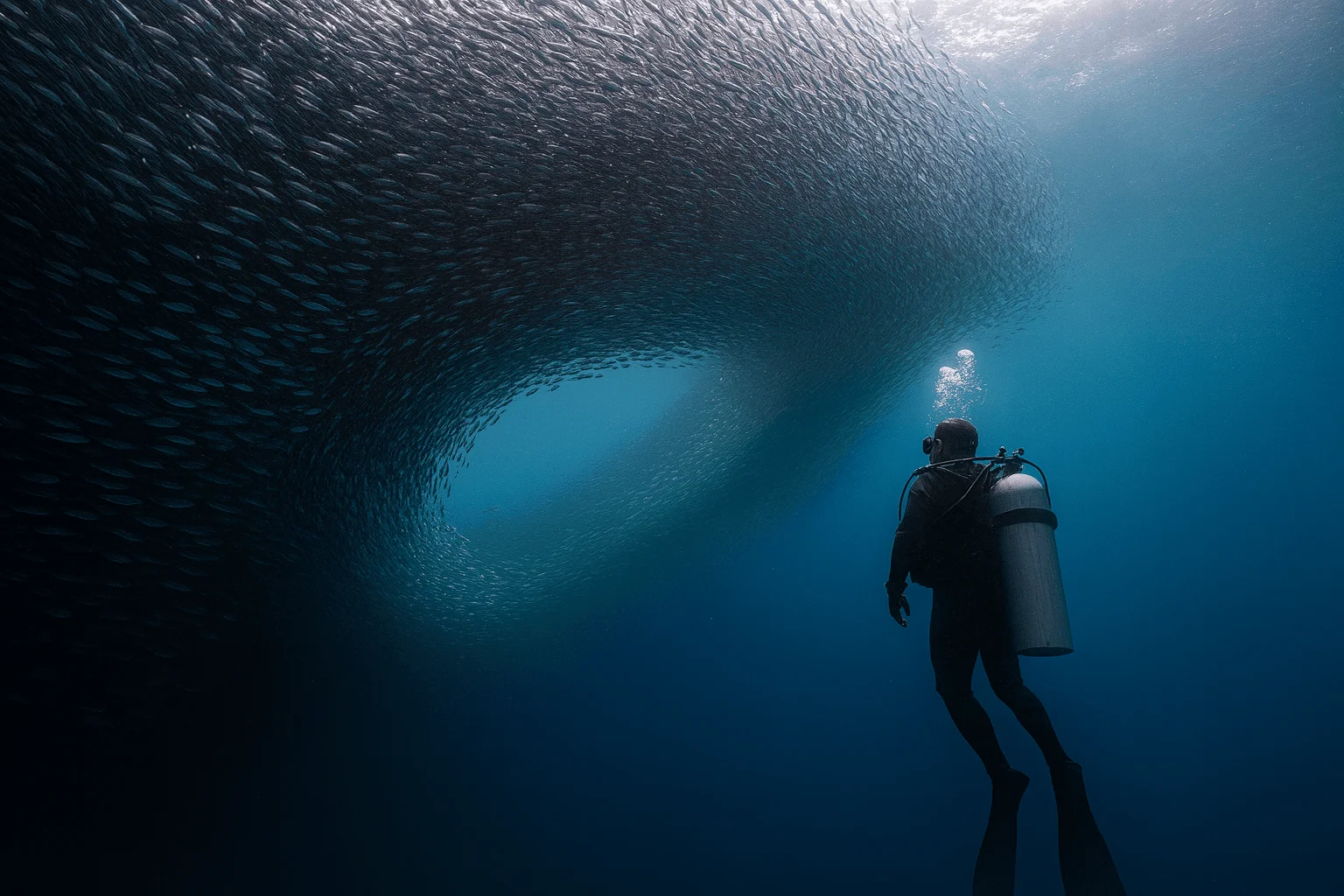Scuba Diving in Moalboal
The Ultimate Guide
Moalboal is a laid‑back beach town on the west coast of Cebu known for its spectacular sardine run and easy access to Pescador Island. Vast clouds of millions of sardines swirl just off Panagsama Beach all year, creating a shimmering wall of fish that you can dive or snorkel through. Just offshore, the limestone island of Pescador offers steep walls, caverns and canyons covered in hard and soft corals; turtles, sea snakes, frogfish, schooling jacks and the occasional thresher or whitetip reef shark can be seen here. Many other sites along the coast feature shallow coral gardens and sandy slopes teeming with nudibranchs, cuttlefish and reef fish, making Moalboal perfect for both beginners and experienced divers.
Difficulty
Easy
Temperature
26-30°C
Visibility
10-30m

Diving Highlights
Best Months to Dive
Getting to Moalboal for Diving
✈️Transportation
Fly into Mactan–Cebu International Airport (CEB).
From Cebu City’s South Bus Terminal, take an air‑conditioned bus or van heading to Moalboal; the journey takes about 3 hours and costs less than US$5.
Alternatively, private transfers can be arranged through dive resorts or taxi drivers.
Once in Moalboal town, most dive shops and guesthouses are clustered around Panagsama Beach, a short tricycle ride from the bus stop.
Day boats depart from Panagsama to reach Pescador Island in 20 minutes.
Country
Philippines
Currency
Philippine Peso
Electricity
220V, 60Hz, Type A/B plugs
Cost of a Dive Trip in Moalboal
Day Trip
Dive Resort
Liveaboard
Meal
Accommodation
Best Dive Sites in Moalboal
🐠Sardine Run (Panagsama)
Just metres off Panagsama Beach, millions of sardines form a swirling ball that stays year‑round at depths of 5–15 m. Divers and snorkellers can drop into the middle of the school and watch it split and reform around them. Occasional predators such as jacks, thresher sharks and tuna dart through the baitball, adding extra excitement.
🐢Pescador Island – Cathedral
Pescador Island’s south side is famous for the Cathedral, a large cavern opening at 30 m that allows sunlight to penetrate through archways and chimneys. Around the cavern the wall is covered in sea fans, sponges and hard corals, with schools of trevallies, snapper, frogfish and reef sharks. It’s suitable for intermediate divers due to depth and occasional currents.
🦈Pescador Island – North Wall
The north side of Pescador features a vertical wall dropping to 40 m, riddled with cracks and overhangs. Colourful soft corals and whip corals cover the surface, hiding frogfish, pipefish and nudibranchs. Schools of yellowtail snapper, parrotfish and occasional sea snakes patrol the reef, while the blue holds the possibility of pelagic visitors.
🐙Tongo Point
Located a short boat ride south of Panagsama, Tongo Point features a sloping reef dropping from 5 m to 30 m with patches of hard corals and sandy areas. This site is ideal for spotting turtles grazing on seagrass, blue‑ringed angelfish, lionfish and cuttlefish. Night dives reveal octopus, crabs and colourful nudibranchs.
🐚Airplane Wreck (Basdiot)
A small two‑seater airplane was deliberately sunk near Basdiot in 1992 to form an artificial reef. Sitting upright on the sandy bottom at 18 m, the wreck is now encrusted with soft corals and sponges and surrounded by schools of batfish and snapper. Curious lionfish patrol the cockpit and fuselage, making it a quirky and photogenic dive.
What Divers Say About Diving in Moalboal
Sarah Chen
Scuba InstructorI had heard about Moalboal’s sardine run for years, but nothing prepares you for being enveloped in a living, shimmering tornado of fish. Diving right off Panagsama Beach, you descend just a few metres and suddenly you’re in the middle of millions of sardines swirling around you like a silver cloud – it’s hypnotic and unforgettable. On other days we hopped over to Pescador Island where huge sea fans decorate the walls and we found turtles snoozing under overhangs, colourful reef fish and the occasional reef shark cruising by. Between dives the vibe in town is equally fun: barefoot restaurants, cheap street food and cold San Miguels, and sunsets over the Tanon Strait. Moalboal may be small, but the combination of easy shore dives, world‑class underwater spectacles and relaxed backpacker charm kept me there far longer than planned.
Frequently Asked Questions About Diving in Moalboal
What marine life can I see?
The sardine run is the star attraction – millions of sardines off Panagsama Beach – along with turtles, sea snakes, jacks and occasional thresher or whitetip sharks at Pescador Island. Macro enthusiasts can find frogfish, nudibranchs, seahorses and cuttlefish.
Is Moalboal suitable for beginners?
Yes. Many sites are shallow and calm, including the sardine run which starts around 5–10 m. Dive centres also arrange introductory dives and PADI courses.
How many dive sites are there?
There are over 20 dive sites including the sardine run, Pescador Island’s north and south walls, Tongo Point, Airplane Wreck and numerous house reefs along the coast.
What are the water temperatures and visibility?
Water temperatures range between 26–30 °C. Visibility averages 10–30 m and is best during the dry season.
Do I need a liveaboard to dive Moalboal?
No, all sites are accessible by day boat or shore. Liveaboards occasionally pass through as part of longer Visayas itineraries, but aren’t necessary.